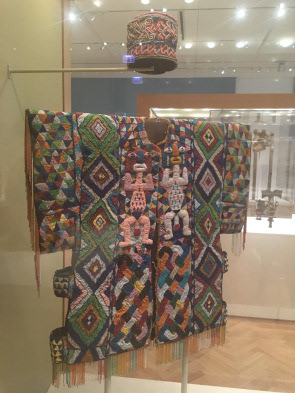I've recently been reminiscing about the good old pre-COVID days when you could take spontaneous trips, travel and just be outside. Instead I'm taking a trip down memory lane with my first visit to the Art Institvte of Chicago.
I had wanted to see this museum for a while, after learning they have a large, permanent collection of Nigerian (specifically Yoruba, Igbo & Benin) art. I do have thoughts about this particular collection belonging to Chicago, as opposed to its original birthplace, however overall it was a really educational experience. For instance, I learnt:
(i) In traditional Yoruba sculpture, older women are often represented as birds on top of a head.
(ii) Blue is a color special to the Yoruba tribe due to natural dyes and pigments found locally. (think: "Adire")
(iii) A common type of Yoruba sculpture is Ere Ibeji (twin sculptures), as the tribe has one of the highest twin birth rates in the world. See below:
(iv) Elderly women were seen as holders of great political and supernatural knowledge, for that reason, there are sculptures of a senior wife crowning an Ogaga (King)-see below:
Ere Ibeji (Twin sculptures)
Opo Ogaga from Ikere, Nigeria
It was also interesting to identify the differences between the igbo and Yoruba sculptures: compared to the former, the Yoruba sculptures had more tribal marks, more stylized (exaggerated) figurines and more ceremonial/symbolic ornaments. Additionally, most of the female yoruba figurines had broad shoulders, round tummies and (for lack of a better word) more booty. It occurred to me that Yoruba women may have looked like that in the early 20th century when these were made, and possibly still do today.
The institvte is quite large: I spent 6 hours in there and only saw three exhibitions, which brings us to the second: Western Art. The Institvte had a large impressionist section of very well-known artists. Cailebotte’s famous painting “Paris Street: Rainy Day” (1877) was much bigger than you'd expect from pictures, but that also makes sense, given that it’s a history painting, capturing ordinary life in a glamorized way. See below:
Paris Street: Rainy Day (1877)
If you've heard of the Cire Perdue (lost wax) method of sculpting, it's likely from Edo bronze casting, where it was (is) commonly used. However, I found out popular French impressionist, Edgar Degas, also made his sculptures through the same technique, which involves making a wax sculpture, covering it with a layer of clay, then melting the wax out through a hole at the bottom and replacing it with bronze/metal and then, breaking off the top layer clay. I had learned about Degas as the guy who made *slightly* creepy paintings of young female ballet dancers. But the "Cire Perdue" sculptures were ALSO of young ballet dancers, so I guess he didn’t stray too far.
My new discovery was “Self Portrait” (1865) by Frederic Bazille, who lived with impressionist icon, Claude Monet and apparently was also a key figure in the movement too. He did that thing where you look in a mirror to paint yourself all in one sitting, which I’ve also wanted to do. It was a challenge to himself, as he had just dropped out of medical school to focus on art. I thought that was really inspiring and ended up creating a self-portrait of my own after seeing Bazille's.
Self Portrait, Frederic Bazille
While I enjoyed the Institvte, I did have some regrets: not bringing a notepad to jot down ideas and not being able to see most of the other exhibits, especially the Warhol collection. This actually got me upset because I’ve been lucky enough to see several of the big names in art, but I have never actually seen a Warhol. Better luck next time, I guess. Lastly, here are some other random pickings for viewing pleasure!












